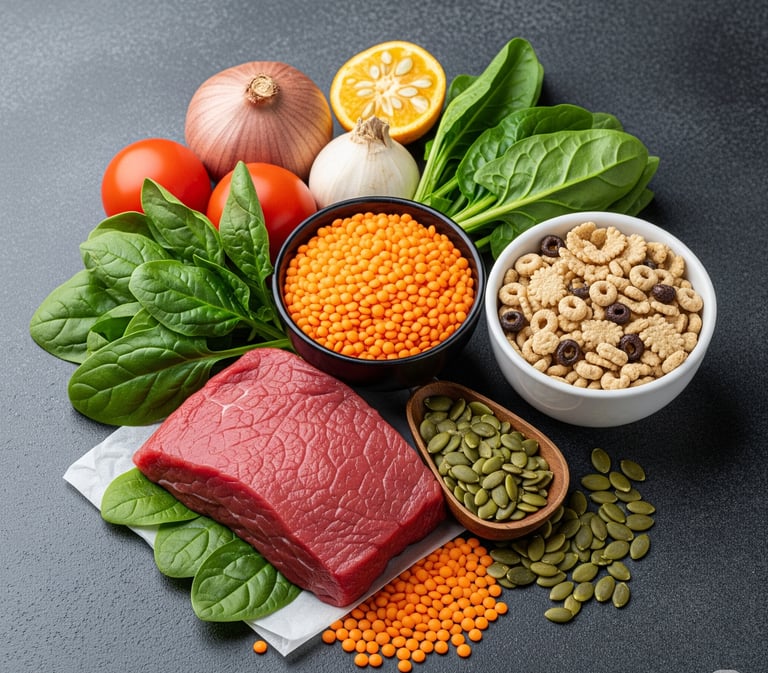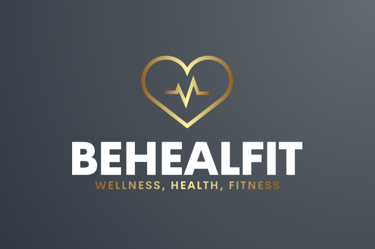Boost Your Iron: Top Foods to Fuel Your Body and Beat Fatigue!
Feeling tired? Discover the best iron-rich foods (plant-based & animal sources) to boost energy, fight fatigue, and improve your overall health naturally!
HEALTHBLOG-LIST
6/24/20257 min read


In Brief
Feeling constantly tired, weak, or struggling to concentrate? You might be experiencing an iron deficiency. Iron is a vital mineral essential for countless bodily functions, especially carrying oxygen in your blood. While iron deficiency is common, especially among women, vegetarians, and athletes, the good news is that many delicious foods are packed with this crucial nutrient. This article will guide you through the top iron-rich foods – from plant-based powerhouses to animal sources – and offer tips to maximize absorption, helping you boost your energy and revitalize your health naturally.
Table of Contents
The Importance of Iron: Why Your Body Needs It
Types of Iron: Heme vs. Non-Heme (and Why It Matters)
Top Iron-Rich Foods to Add to Your Diet
Animal-Based (Heme Iron)
Plant-Based (Non-Heme Iron)
Maximizing Iron Absorption: Smart Food Pairings
Foods and Drinks to Avoid When Boosting Iron
Testimonial: Emily's Journey to Beating Iron-Related Fatigue
When to Consider Iron Supplements (and Consult a Doctor)
Frequently Asked Questions (FAQ) About Iron and Diet
Conclusion: Power Up Your Plate with Iron!
1. The Importance of Iron: Why Your Body Needs It
Iron is an indispensable mineral that plays a central role in several critical bodily functions. Its most well-known function is in blood production and oxygen transport:
Oxygen Carrier: Iron is a key component of hemoglobin, a protein in red blood cells that transports oxygen from your lungs to all the cells and tissues throughout your body. It's also part of myoglobin, which stores oxygen in your muscles.
Energy Production: Without enough oxygen reaching your cells, your body's ability to produce energy effectively is severely hampered, leading to fatigue and weakness.
Immune Function: Iron is vital for a healthy immune system, helping your body fight off infections.
Cognitive Function: It plays a role in brain development and function, affecting concentration, memory, and mood.
Growth and Development: Especially important for children, adolescents, and pregnant women.
When your body lacks sufficient iron, it can lead to iron deficiency anemia, a common condition characterized by fatigue, weakness, pale skin, shortness of breath, dizziness, and poor concentration.
2. Types of Iron: Heme vs. Non-Heme (and Why It Matters)
Not all iron is created equal when it comes to how well your body absorbs it. There are two primary types of dietary iron:
Heme Iron:
Source: Found exclusively in animal products, specifically in hemoglobin and myoglobin.
Absorption: This is the most bioavailable form of iron, meaning your body absorbs it much more efficiently (around 15-35%).
Examples: Red meat, poultry, fish, seafood.
Non-Heme Iron:
Source: Found in plant-based foods and also in animal products (though in lesser amounts than heme iron).
Absorption: Less efficiently absorbed by the body (typically 2-20%), and its absorption can be influenced by other dietary factors.
Examples: Grains, nuts, seeds, vegetables, fruits, fortified foods.
Understanding these differences is crucial for planning an iron-rich diet, especially for vegetarians and vegans who rely solely on non-heme iron.
3. Top Iron-Rich Foods to Add to Your Diet
Whether you prefer animal products or follow a plant-based diet, there are plenty of delicious ways to get your iron!
Animal-Based (Heme Iron)
These are excellent sources due to their high iron content and superior absorption.
Red Meat: Beef (especially lean cuts like sirloin, tenderloin), lamb, and venison are incredibly rich in heme iron.
Example: 3 oz (85g) cooked lean beef: ~2.5-3.5 mg iron
Poultry: Dark meat chicken and turkey contain more heme iron than white meat.
Example: 3 oz (85g) cooked dark turkey meat: ~2.0-2.5 mg iron
Seafood: Clams, oysters, mussels, shrimp, and certain fish (tuna, salmon, sardines) are great sources.
Example: 3 oz (85g) cooked clams: ~2.4 mg iron
Example: 3 oz (85g) canned sardines: ~2.0 mg iron
Liver and Organ Meats: These are some of the most concentrated sources of heme iron.
Example: 3 oz (85g) cooked beef liver: ~5 mg iron
Plant-Based (Non-Heme Iron)
While non-heme iron is less absorbed, consuming these foods regularly and strategically combining them can make a big difference.
Legumes: Lentils, chickpeas, black beans, kidney beans, and soybeans (edamame, tofu) are excellent sources.
Example: 1 cup cooked lentils: ~6.6 mg iron
Dark Leafy Greens: Spinach, kale, Swiss chard, and collard greens are packed with iron.
Example: 1 cup cooked spinach: ~6.4 mg iron
Nuts and Seeds: Pumpkin seeds, sesame seeds, cashews, and almonds are good sources.
Example: 1/4 cup pumpkin seeds: ~4.2 mg iron
Whole Grains: Quinoa, oats, brown rice, and fortified cereals contribute to iron intake.
Example: 1 cup cooked quinoa: ~2.8 mg iron
Dried Fruits: Raisins, prunes, and apricots offer a concentrated dose of iron.
Example: 1/4 cup raisins: ~1.0 mg iron
Certain Vegetables: Broccoli, potatoes (with skin), and mushrooms (especially shiitake) also contain iron.
Example: 1 medium baked potato with skin: ~2.0 mg iron
Blackstrap Molasses: A byproduct of sugar refining, it's surprisingly rich in non-heme iron.
Example: 1 tbsp: ~3.5 mg iron
4. Maximizing Iron Absorption: Smart Food Pairings
Getting iron into your diet is one thing; making sure your body uses it is another. Here's how to boost absorption, especially for non-heme iron:
Pair with Vitamin C: Vitamin C significantly enhances the absorption of non-heme iron.
Examples: Have spinach with orange segments, lentils with bell peppers, or fortified cereal with a glass of orange juice.
Excellent Vitamin C sources: Citrus fruits, bell peppers, strawberries, kiwi, broccoli, tomatoes.
Combine with Heme Iron (for meat-eaters): Even small amounts of heme iron (from meat, poultry, fish) consumed with non-heme iron sources can improve the absorption of the non-heme iron.
Example: Add a few pieces of chicken to a lentil stew or enjoy fish with a side of kale.
Cook in Cast Iron: Cooking acidic foods (like tomato sauce or chili) in a cast iron skillet can leach small amounts of iron into your meal, slightly increasing your intake.
5. Foods and Drinks to Avoid When Boosting Iron
Some substances can inhibit iron absorption, particularly non-heme iron. Limit or avoid these around iron-rich meals:
Phytates/Phytic Acid: Found in whole grains, legumes, nuts, and seeds. While these foods are good iron sources, phytates can bind to iron. Soaking, sprouting, or fermenting can reduce phytate content.
Tannins: Found in tea (especially black tea), coffee, and some wines. Drink these beverages between meals, not with them, if you're trying to boost iron.
Calcium: High calcium intake can inhibit both heme and non-heme iron absorption. If you take calcium supplements, take them at a different time of day than your iron-rich meals or iron supplements.
Oxalates: Found in spinach, kale, and other leafy greens. While these greens contain iron, oxalates can slightly reduce its absorption. Pairing them with Vitamin C helps counteract this.
10 Vital Nutrients You're Probably Missing
6. Testimonial: Emily's Journey to Beating Iron-Related Fatigue
"For years, I was just exhausted. I'd wake up tired, feel sluggish all day, and my brain felt foggy. I thought it was just my demanding job. After a blood test, my doctor said my iron levels were really low. I started focusing on my diet using the tips in this article. I added lentils to my salads, swapped my morning white bread for oatmeal with berries, and made sure to have bell peppers with my spinach. It took a few weeks, but slowly, the fog lifted, and my energy came back! I couldn't believe the difference just changing my food choices made. Now, I feel so much more vibrant and ready to tackle my day. Iron-rich foods truly are a game-changer!" – Emily R.
7. When to Consider Iron Supplements (and Consult a Doctor)
While dietary changes are always the first line of defense, sometimes they aren't enough.
Symptoms Persist: If you continue to experience symptoms of iron deficiency despite consistent dietary changes.
Diagnosed Deficiency: If a blood test confirms iron deficiency anemia.
Specific Risk Groups: Pregnant women, individuals with certain malabsorption disorders (like celiac disease), or those with heavy menstrual bleeding often require supplementation.
Vegetarians/Vegans: While a well-planned plant-based diet can meet iron needs, some individuals may benefit from supplementation.
Important: Do not start iron supplements without consulting a doctor. Excess iron can be harmful and lead to iron overload, which can damage organs. A healthcare professional can diagnose the deficiency, recommend the appropriate type and dose of supplement, and monitor your levels.
8. Frequently Asked Questions (FAQ) About Iron and Diet
Still have questions about iron-rich foods? Here are clear answers:
Can vegetarians and vegans get enough iron from their diet? Yes, it's entirely possible with careful planning. Focus on consistently consuming a variety of non-heme iron sources (legumes, dark leafy greens, nuts, seeds, whole grains) and always pair them with Vitamin C-rich foods to maximize absorption.
Does cooking food affect its iron content? Cooking generally does not significantly reduce the iron content of food. In some cases, cooking in cast iron can even add a small amount of iron. However, boiling may cause some water-soluble nutrients to leach out, so steaming or roasting is often preferred.
What are the symptoms of too much iron (iron overload)? Symptoms of iron overload (hemochromatosis) can include fatigue, joint pain, abdominal pain, liver problems, and heart issues. It is usually genetic but can also occur from excessive supplementation. This is why self-supplementation is not advised.
Is fortified cereal a good source of iron? Fortified cereals can be a good source of non-heme iron, especially for those struggling to meet their daily requirements. However, always choose options low in added sugars and pair them with Vitamin C (e.g., orange juice or berries).
How long does it take to increase iron levels through diet? Increasing iron levels through diet alone can take several weeks to a few months, depending on the severity of the deficiency and the consistency of dietary changes. Supplementation can raise levels faster under medical supervision.
Are iron deficiencies more common in women? Yes, iron deficiency is significantly more common in women, primarily due to blood loss during menstruation and increased iron needs during pregnancy.
9. Conclusion: Power Up Your Plate with Iron!
Iron is truly a foundational mineral for your energy, health, and overall well-being. Recognizing the warning signs of deficiency is crucial, but empowering yourself with knowledge about iron-rich foods is the real game-changer. Whether you prefer animal-based sources like lean meats and seafood, or plant-based powerhouses like lentils, spinach, and pumpkin seeds, incorporating these foods strategically and maximizing absorption with Vitamin C can help you combat fatigue, boost your vitality, and keep your body functioning at its best. Fuel your body with the iron it needs, and feel the difference!
